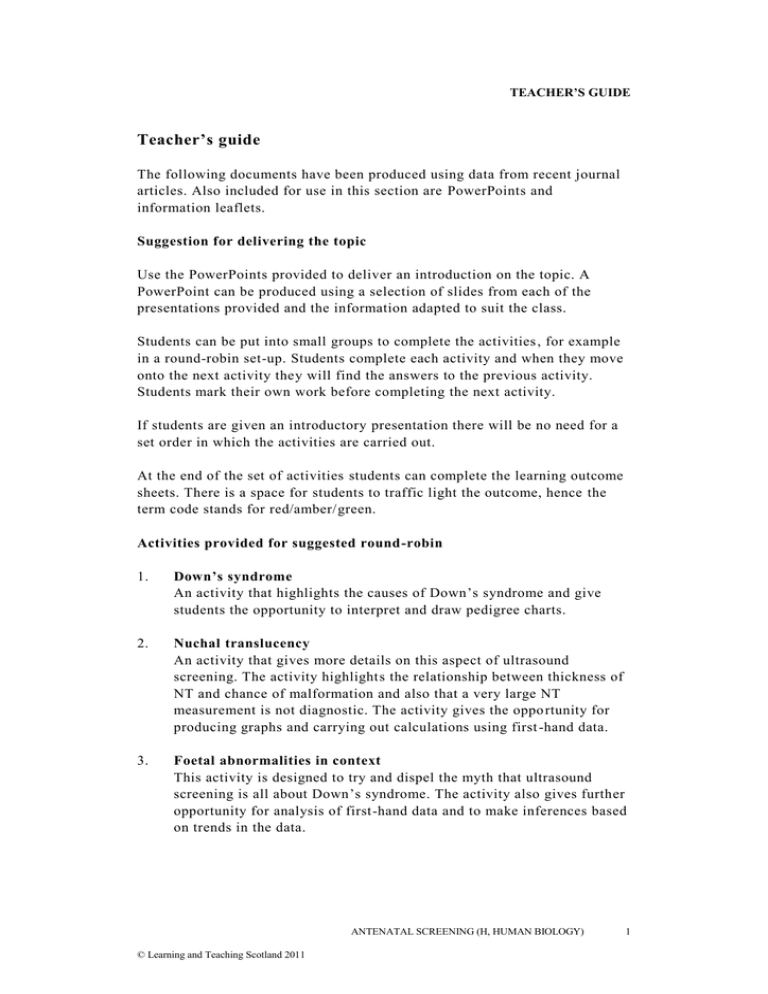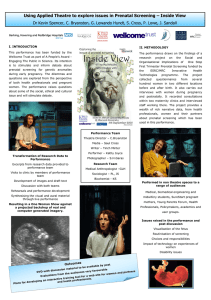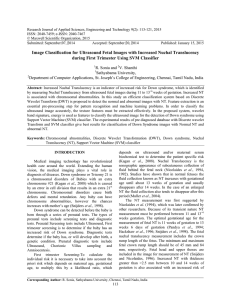Teacher’s guide
advertisement

TEACHER’S GUIDE Teacher’s guide The following documents have been produced using data from recent journal articles. Also included for use in this section are PowerPoints and information leaflets. Suggestion for delivering the topic Use the PowerPoints provided to deliver an introduction on the topic. A PowerPoint can be produced using a selection of slides from each of the presentations provided and the information adapted to suit the class. Students can be put into small groups to complete the activities , for example in a round-robin set-up. Students complete each activity and when they move onto the next activity they will find the answers to the previous activity. Students mark their own work before completing the next activity. If students are given an introductory presentation there will be no need for a set order in which the activities are carried out. At the end of the set of activities students can complete the learning outcome sheets. There is a space for students to traffic light the outcome, hence the term code stands for red/amber/green. Activities provided for suggested round-robin 1. Down’s syndrome An activity that highlights the causes of Down’s syndrome and give students the opportunity to interpret and draw pedigree charts. 2. Nuchal translucency An activity that gives more details on this aspect of ultrasound screening. The activity highlights the relationship between thickness of NT and chance of malformation and also that a very large NT measurement is not diagnostic. The activity gives the oppo rtunity for producing graphs and carrying out calculations using first -hand data. 3. Foetal abnormalities in context This activity is designed to try and dispel the myth that ultrasound screening is all about Down’s syndrome. The activity also gives further opportunity for analysis of first-hand data and to make inferences based on trends in the data. ANTENATAL SCREENING (H, HUMAN BIOLOGY) © Learning and Teaching Scotland 2011 1 TEACHER’S GUIDE 4. Screening tests This activity will give the opportunity for students to gain a greater understanding of the difference between a screening test and a diagnostic test. Students should also be more able to describe the factors screened for in prenatal care and be able to explain the importance of accurate dating of pregnancy in relation to screening tests. Students should also gain a greater understanding o f falsepositive and false-negative results. The PowerPoint showing ultrasound images can be used to print off slides to show features that are screened for in an anomaly scan. 5. Diagnostic tests The two booklets ‘Chorionic villus sampling – information for parents’ and ‘Amniocentesis test – information for parents’ need to be available for students to use to make notes. It is hoped that this section of the course and these activities will stimulate discussion on the wider implications of prenatal diagn osis and allow students to explore their own values when it comes to the difficult decisions that may need to be made. Also, it is hoped that the activities will highlight that prenatal diagnosis is not all about Down’s syndrome. It is also hoped that students will gain an understanding that prenatal diagnosis is not about ‘seek and destroy’; medical advances mean that there are now far more options available when making decisions about a foetus with malformations. It is anticipated that five round robin activities should take no longer than a typical double period. There are some aspects of the activities that are designed to stretch more able students and it is anticipated that many students may need direction to complete some of the more challenging data analysis questions. The glossary can be enlarged and used as posters during the topic or laminated and passed between students when needed. This will encourage attention to correct spelling and remind students of definitions. 2 ANTENATAL SCREENING (H, HUMAN BIOLOGY) © Learning and Teaching Scotland 2011 TEACHER’S GUIDE Bibliography Journal articles used for information B. Dane, C. Dane, A. Cetin, M. Kiray, D. Sivri and M. Yayla. Pregnancy outcome in fetuses with increased nuchal translucency. Journal of Perinatology 2008; 28: 400–404. L. D. Allan. The mystery of nuchal translucency. Cardiology in the Young 2006; 16: 11–17. © Cambridge University Press. T. Reynolds, G. Vranken, J. Van Nueten and J. Aldis. Down’s syndrome screening: population statistic dependency of screening performance . Clinical Chemistry and Laboratory Medicine 2008; 46(5): 639–647. K. Spencer, V. Souter, N. Tul, R. Snijders and K. H. Nicolaides. A screening program for trisomy 21 at 10–14 weeks using fetal nuchal translucency, maternal serum free β-human chorionic gonadotropin and pregnancy associated plasma protein-A. Ultrasound in Obstetrics Gynecology 1999; 13: 231–237. A. Sau, K. Langford, B. Auld1 and D. Maxwell. Screening for trisomy 21: the significance of a positive second trimester serum screen in women screen negative after a nuchal translucency scan. Journal of Obstetrics and Gynaecology 2001; 21(2): 145–148. F. Audibert, M. Dommergues, C. Benattar, J. Taieb, J.-C. Thalabard and R. Frydman. Screening for Down syndrome using first-trimester ultrasound and second-trimester maternal serum markers in a low -risk population: a prospective longitudinal study. Ultrasound in Obstetrics Gynecology 2001; 18: 26–31. G. R. Devore. Trisomy 21: 91% detection rate using second -trimester ultrasound markers. Ultrasound in Obstetrics Gynecology 2000; 16: 133–141. V. Bansal, S. Suresh, I. Suresh, S. Jagadeesh, G. J. Fazal. Genetic counseling in chromosomal abnormalities. Journal of Prenatal Diagnosis and Therapy, January–June 2010; 1: 14–19. ANTENATAL SCREENING (H, HUMAN BIOLOGY) © Learning and Teaching Scotland 2011 3


